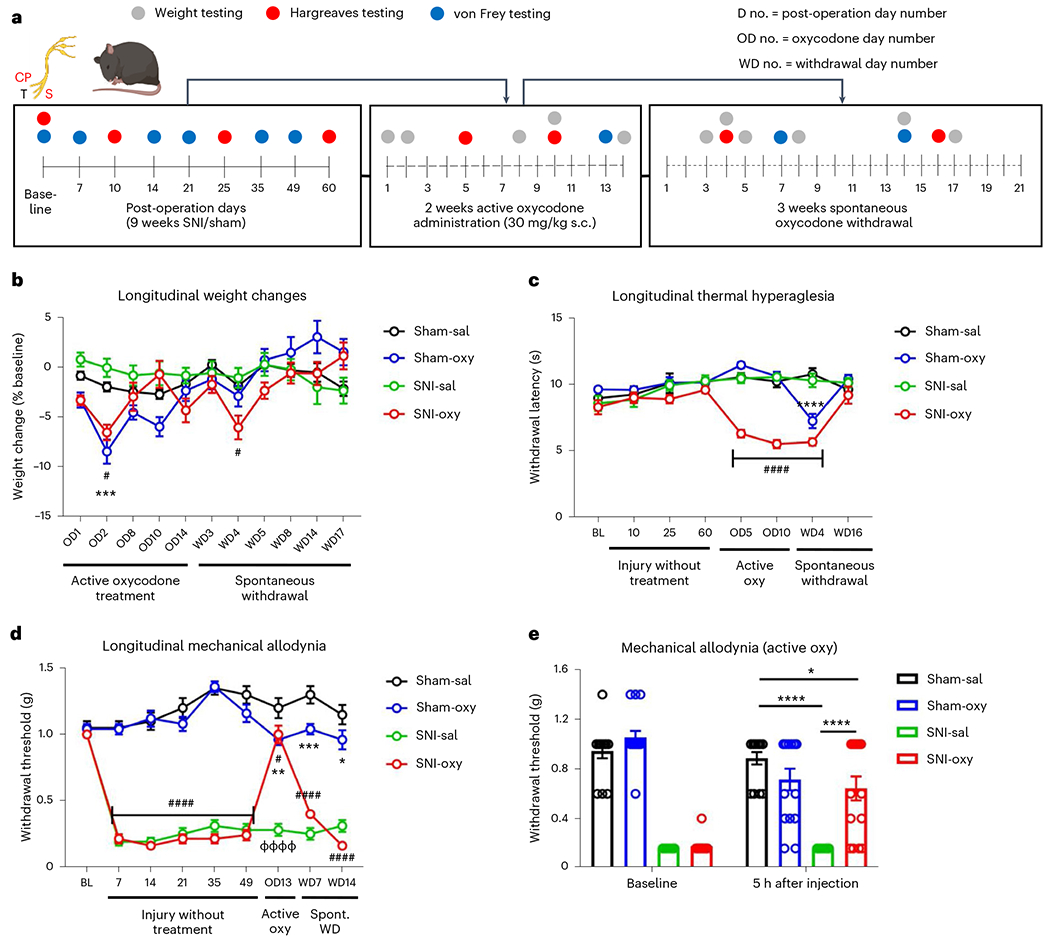Fig. 1 |. Chronic oxycodone exposure and spontaneous oxycodone withdrawal produce weight loss and sensory deficits in long-term spared nerve injury and pain-free mice.

a, Schematic timeline depicting oxycodone exposure In male chronic SNI and sham mice. b, Weight was affected by oxycodone administration in both SNI and sham cohorts as compared with Sham-Sal-treated controls (Sham-Sal n = 11, Sham-Oxy n = 16; SNI-Sal n = 11, SNI-Oxy n = 14; repeated-measures two-way analysis of variance (ANOVA) interaction F30,480 = 6.653, P < 0.0001; Tukey’s multiple comparisons Sham-Oxy versus Sham-Sal OD2 q = 6.029, d.f. = 528, P = 0.0001; SNI-Oxy versus Sham-Sal OD2 q = 4.131, d.f. = 528, P = 0.019, WD4 q = 3.784, d.f. = 528, P = 0.0384). No significant weight change was observed between SNI controls (SNI-Sal) as compared to Sham-Sal. c, Oxycodone exposure produced significant and progressive thermal hyperalgesia in SNI mice (SNI-Oxy) at 5 d of oxycodone administration as compared to the Sham-Oxy group. Oxycodone-induced thermal hyperalgesia continued during spontaneous withdrawal in SNI-Oxy mice. Sham-Oxy mice displayed thermal hyperalgesia only during spontaneous withdrawal at early time points (WD4) (Sham-Sal n = 8, Sham-Oxy n = 10; SNI-Sal n = 8, SNI-Oxy n = 9; repeated-measures two-way ANOVA interaction F21,217 = 8.826, P < 0.0001; Tukey’s multiple comparisons. SNI-Oxy versus Sham-Sal OD5 q = 10.53, d.f. = 248, P < 0.0001, OD10 q = 11.64, d.f. = 248, P < 0.0001; Sham-Oxy versus Sham-Sal WD4 q = 8.943, d.f. = 248, P < 0.0001; SNI-Oxy versus Sham-Sal WD4 q = 12.63, d.f. = 248, P < 0.0001). d, Oxycodone-reduced mechanical thresholds in sham cohorts at 13 d of drug administration. During spontaneous withdrawal, Sham-Oxy mice displayed mild but significant mechanical allodynia up to 14 d after drug cessation as compared to Sham-Sal controls. SNI-Oxy mice showed significantly decreased mechanical allodynia during oxycodone administration (day 13) compared to all earlier time points under nerve injury, but thresholds returned to baseline levels during drug withdrawal (Sham-Sal n = 8, Sham-Oxy n = 10; SNI-Sal n = 8, SNI-Oxy n = 9; repeated-measures two-way ANOVA interaction F24,248 = 20.75, P < 0.0001; Tukey’s multiple comparisons, SNI-Oxy pretreatment days 7–49 P < 0.0001; Tukey’s multiple comparisons, OD13 SNI-Oxy versus Sham-Sal q = 4.07, d.f. = 279, P = 0.0223; SNI-Oxy versus SNI-Sal q = 14.65, d.f. = 279, P < 0.0001; Sham-Oxy versus Sham-Sal OD13 q = 5.003, d.f. = 279, P = 0.0027; Sham-Oxy versus Sham-Sal WD7 q = 5.42, d.f. = 279, P = 0.0009, WD14 q = 3.961, d.f. = 279, P = 0.0278). e, In a separate cohort, oxycodone alleviated SNI-induced mechanical allodynia 5 h after administration (13 d of daily treatment; Sham, Sal n = 14, Oxy, n = 15; SNI, Sal n = 14, Oxy n = 15; (F3,54 = 16.22, P < 0.0001; Sidak’s multiple comparisons, SNI-Sal versus Sham-Sal t = 8.717, d.f. = 108, P < 0.0001; SNI-Oxy versus SNI-Sal t = 5.897, d.f. = 108, P < 0.0001). Data indicate the mean ± s.e.m. Significance (P < 0.05) was calculated by means of two-way ANOVA with Tukey’s post hoc test for b–d and Sidak’s post hoc test for direct comparison of Sham-Oxy versus Sham-Sal (*P < 0.05, **P < 0.01, ***P < 0.001, ****P < 0.0001), SNI-Oxy versus Sham-Sal, (#P < 0.05, ##P < 0.01, ###P < 0.001, ####P < 0.0001), SNI-Oxy versus SNI-Sal (ΦΦΦΦP < 0.0001). Oxy, oxycodone; Sal, saline; WD, withdrawal day; OD, oxycodone administration day.
